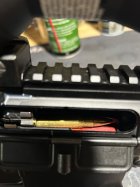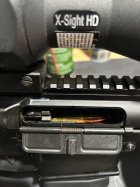It’s really complex, and I don’t understand it completely, but I know more or less what happens. Setting aside powder burn rate, you have a rise to peak pressure that is rapid acceleration, rapid creation of gasses, medium acceleration as powder continues to burn and expand. Slow acceleration after the powder gas burned out but the gasses are still expanding, then finally deceleration where friction becomes greater than remaining pressure in the barrel.
Here’s the basics.
Pressure over time overcoming resistance. That three lines on a graph. If we use the load data pictured at the start of the thread and look at Accurate #2 and 5744 with the 190 grain subx bullet. They both exit the barrel at say 1050 fps after starting at 0 and traveling 24”. The #2 load does it with 60% less powder while creating 60% more pressure. What we don’t know is the time it took to create that velocity. All we know is that after traveling the same distance, they were at the same speed. That means that before that intersection one bullet was traveling slower than the other and after that point the other bullet was traveling slower. One rate of acceleration after the initial slower boost finally overcame the other. This is where you need to know time in the barrel vs distance traveled. They will be different for each load.
Smokeless powder needs containment to be effective, if it can’t build pressure, if the gasses created by burning aren’t contained, pressure can not build up. If you throw a loaded round in the fire, if you’re hit by anything, it’s likely to be the primer. The lightest component. Then whatever is lighter, the brass or the bullet. In theory if the primer pops out and the flash hole is big enough, there may not be enough pressure to separate the brass from the bullet.
Now the fun part.
Peak pressure is the point where volumetric efficiency changes. Powder needs containment to build pressure. A moving bullet is more or less a pressure relief valve. As the bullet moves, the volume of the containment vessel increases. The burn rate and rate gasses expanding decreases. How this plays out is that a 30 caliber bullet driven by the exact same powder charge will have less muzzle velocity than a 22 caliber bullet of the same weight and same barrel length. You have the same potential energy in a larger container, less energy will be developed in the larger container.
Resistance of the bullet traveling down the barrel, changes the rate of expansion. Bearing surface length, weight, lube if it’s a cast bullet all change the equation. Remember the bullet is the pressure relief valve, if the bullet doesn’t move, hopefully the primer pops and the pressure has a place to go. If that’s not enough relief stronger parts start to let loose.
That’s the premise of a 125 grain bullet using the same charge weight to match the velocity of a 240 grain bullet. There is so little resistance provided by the 125 grain bullet, the powder develops so little pressure that you have to add more powder. Basically the burn rate has changed, peak pressure has changed and the lighter bullet is followed out the muzzle by a measurable amount partially and totally un burned powder. This is manipulation of a burn rate. It’s possible to turn a fast burning powder, into a slow burning powder. Tougher to turn a slow powder into a fast powder.
Fast powders for subsonic is more about sound than velocity. The higher the peak pressure, the lower the muzzle pressure. The lower the muzzle pressure, the lower the sound signature. If all the powder burns it’s a plus so combustible powder is not filling your suppressor turning it into a bomb.
With supers you don’t have an artificial velocity limit. You load to a pressure point. With subs pressure is rarely a limiting factor, you load to a specific velocity window. it has a different set of variables a different set of factors that require a slightly different approach. There has been years of refining most cartridges that see today. There is a road map. This cartridge in that length barrel with this weight bullet performs best at this velocity. That’s not really science and engineering, it’s experience. All the fancy equations do is cut down development time when changing components, burning out a barrel about the time you have your load developed. Subsonic shooting Does not have that kind of data base yet.
I’m not knocking the science but the phrase “listen to the target” trumps the equation says every day.
None of this is any different shooting supers. It’s just velocity hides a lot of issues. If you have a 200 grain bullet at 3000 fps and SD’s in the low teens, it may not show up on target until 1000 yards. At 1000 fps it shows at 50. You actually need tighter tolerances to shoot subs MOA at any distance than you do supers.
Edit to add
Once all that sinks in, we can talk about the relationship between gas pressure and volume need to cycle a gas operated semi auto, and why burn rate makes a difference.













